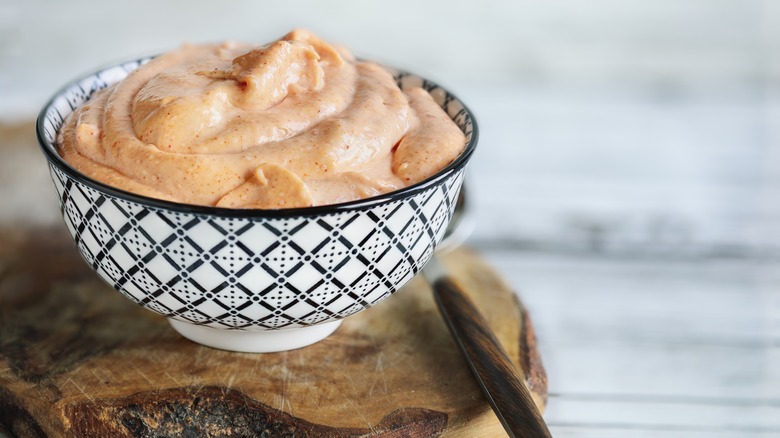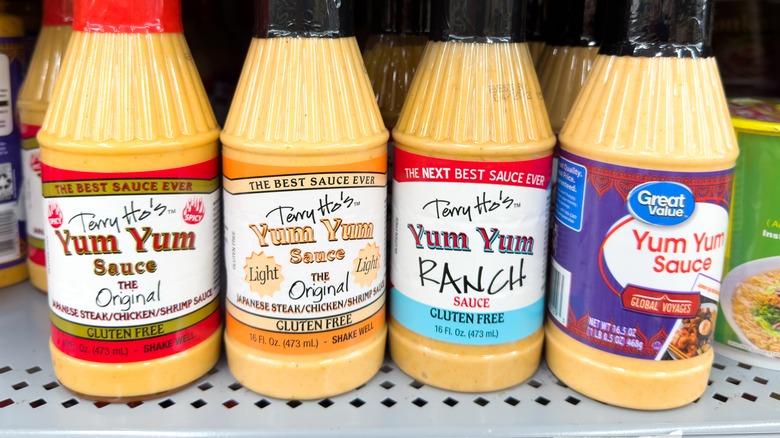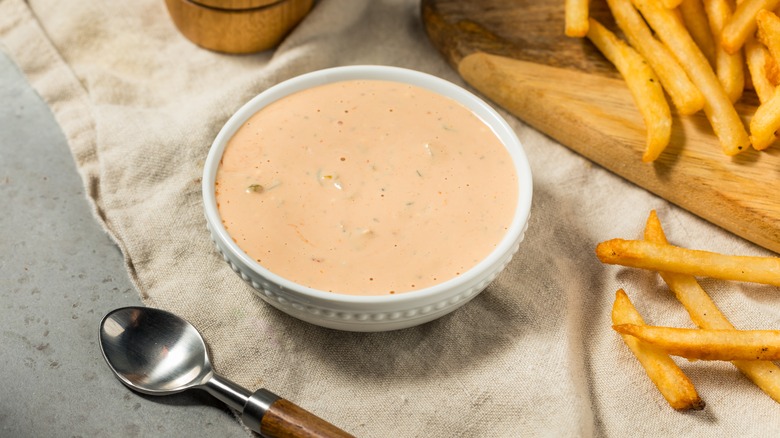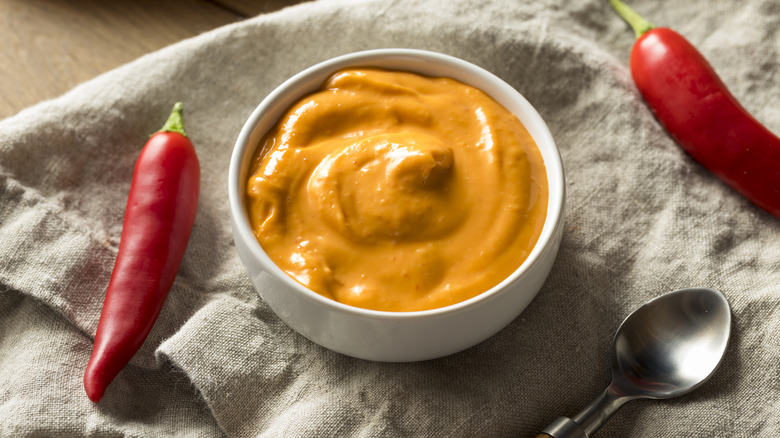Is There A Difference Between Yum Yum Sauce And Spicy Mayo?
Ask any foodie and you'll get the same answer: All dipping sauces are not created equal. Even in the fast food drive-thru lane, one of the crucial questions surrounding your order is "What kind of sauce do you want with that?". From honey mustard to barbecue and beyond, the matter of the sauce is no small game, today, we're deep-diving into two savory, crave-able, and visually near-identical condiments in the oeuvre: Yum yum sauce and spicy mayo.
Both sauces are pinkish-orange, thick and lush, and they're served alongside a lot of the same dishes. Yum yum sauce and spicy mayonnaise also share a mayo base. But, their foundational ingredient and aesthetic hue are about as far as the similarities extend between these two creamy condiments.
Yum yum sauce is a tad more adaptable than spicy mayo. Many North American-based hibachi restaurants have their own unique proprietary yum yum recipes. By contrast, a spicy mayo "recipe" entails little more than how much sriracha chili sauce you add to the mayo. With these sauces, it's all about the ingredient lineups and spiciness levels — which couldn't be more different.
What is yum yum sauce?
Yum yum sauce (not to be confused with aioli or remoulade) is typically some combination of ketchup or tomato paste, rice vinegar, garlic, sugar, paprika, soy sauce, mirin, and hot sauce or sriracha. To make it, all the ingredients are simply whisked together and sometimes thinned with water to the desired consistency. This sweet, slightly tangy, ultra-creamy orange-pink sauce isn't dissimilar from the popular "fry sauce" condiment of the American South, which combines mayo and ketchup.
Yum yum sauce (or as it's also perplexingly called, "white sauce") might have started off when two cultures' undying love for eggy emulsions met and blossomed. Though yum yum is a staple of hibachi, aka Japanese teppanyaki-style cooking, it doesn't seem to be Japanese in origin. Steakhouses in Japan don't serve their meats with the sauce. Polly Adema, culinary anthropologist and director of food studies at California's College of the Pacific, theorizes that yum yum began with the intersection of American and modern Japanese palettes, which share a love for mayonnaise. Adema told NPR, "Which came first: an affection for mayo or a mayo-enriched dish? [It's] one of those questions we may never be able to answer."
Indeed, yum yum sauce tastes as fitting on hibachi-style grilled peppers as it does on tater tots. The Yum Yum Sauce brand by Hibachi Express restaurant owner Terry Ho lauds itself as "the 'original' Japanese shrimp/steak sauce" and offers a myriad of variations, from classic to spicy and "yum yum ranch."
What is spicy mayo?
Unlike yum yum sauce's more involved lineup of ingredients, spicy mayo is a simple two-parter: mayonnaise and sriracha. It's a condiment as unpretentious as it is versatile and iconic. The rich umami flavor of the mayo meets the sweet-garlicky heat of the sriracha for a duo that's greater than the sum of its parts. Spicy mayo doesn't share the cultural ties that yum yum sauce enjoys in Japanese-American hibachi restaurants. With a glance further back into history, it can be called a product of an unlikely French-Thai culinary fusion (mayo is French in origin, and sriracha hails from Thailand).
It's wicked easy to make classic spicy mayo, or even a vegan version by using an egg-free mayonnaise. To assemble, start with one part sriracha per four parts mayonnaise (e.g. ¼ cup of sriracha per cup of mayo). From there, you can adjust the proportions to suit your spiciness preference. Extra customization is yours to decide; for a Japanese-inspired, umami-rich spicy mayo, combine Japanese Kewpie mayo, sriracha, and a squeeze of fresh lime juice. You could even call this condiment variation "the best of both worlds" between yum yum and spicy mayo. But generally speaking, when you see the words "spicy mayo" on a menu or store-bought bottle, expect just regular mayonnaise and sriracha.
Yum yum sauce is mild, while spicy mayo brings the heat
The most immediate difference between these two mayo-based sauces is their flavor. Yum yum sauce is mild while spicy mayo is (surprise) spicy. Yum yum is also more about bringing sweet-savory flavor than packing the heat, while the reverse is true of spicy mayo. As such, this difference in flavor and intensity colors the dishes with which these condiments are commonly used.
Tangy, umami-heavy yum yum sauce is typically served as a dip or drizzled from a squeeze bottle. Pour it over a salmon poke bowl, use it as a flavorful dip for fries or raw veggies, or mix it with tinned fish for a knockout tuna salad. It's an easily-digestible fit for the breakfast table alongside steak and eggs, huevos rancheros, or eggs Benedict. For dinner, pair it with quinoa, tacos, shrimp, sushi, stir fry, grilled zucchini, crab cakes, steak fried rice, or crispy tofu lettuce wraps. We love it as a moisture element and pop of color on these Yum Yum chicken sliders with red cabbage slaw.
Meanwhile, punchy, bold spicy mayo makes a terrific spread for burgers and sandwiches, like a classic grilled cheese sandwich to lend a little fiery liveliness. It's also great atop milder dishes like grain bowls, sweet potato fries, charred shishito peppers, avocado toast or MSG tomato toast, chicken nuggets, fried pickle spears, banh mi, and grilled corn on the cob.



